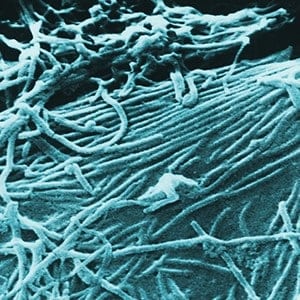Rate of rise in cases significantly increased in August in Liberia and Guinea, around the time that a mass quarantine was put in place
New research published today in the online journal PLoS Outbreaks predicts new Ebola cases could reach 6,800 in West Africa by the end of the month if new control measures are not enacted.
Arizona State University and Harvard University researchers also discovered through modelling analysis that the rate of rise in cases significantly increased in August in Liberia and Guinea, around the time that a mass quarantine was put in place, indicating that the mass quarantine efforts may have made the outbreak worse than it would have been otherwise. Deteriorating living and hygiene conditions in some of the quarantined areas sparked riots last month. Sierra Leone began a three day country-wide quarantine today, where all citizens have been asked to stay at home, said Sherry Towers, research professor for the ASU Simon A. Levin Mathematical, Computational and Modelling Sciences Center (MCMSC).
“There may be other reasons for the worsening of the outbreak spread, including the possibility that the virus has become more transmissible, but it’s also possible that the quarantine control efforts actually made the outbreak spread more quickly by crowding people together in unsanitary conditions,” Towers said.
The study, “Temporal variations in the effective reproduction number of the 2014 West Africa Ebola outbreak,” is authored by Towers, Oscar Patterson-Lomba of the Harvard School of Public Health and Carlos Castillo-Chavez, ASU Regent’s professor and MCMSC executive director.
Researchers assessed whether or not attempted control efforts are effective in curbing the ongoing West African Ebola outbreak that has spread over a large geographic area, causing thousands of infections and deaths. Because the outbreak has spread to densely populated areas, the risk of international spread is increased. Also compounding the problem is a lack of resources for effective quarantine and isolation in the under-developed countries that have been affected, and the high mobility of the population in a region with porous borders, according to the study.
“No licensed vaccine or specific treatment for the disease is currently available. This leaves improved hygiene, quarantine, isolation and social distancing as the only potential interventions,” Castillo-Chavez said. “Improved control measures must be put into place.” On Tuesday, President Obama announced that 3,000 US troops and medical personnel would be sent to the region to help control the outbreak, he added.
Researchers examined the current outbreak data for Guinea, Sierra Leone and Liberia through statistical research methods up until Sept. 8, 2014, as estimated by the World Health Organization. The analysis examines the local rates of exponential rise to estimate how the reproduction number of cases appears to be changing over time. Calculations showed a range of 6,800 predicted new cases at the upper end of the spectrum and 4,400 on average. The study was funded by the National Institute of General Medical Sciences at the National Institutes of Health.



Found this is college.
The incubation time between that when the virus passes to a new victim and when he or she (and the immediate community) are aware of this new infected person, is so short in the case of ebola that a practical way of stopping the spread of the disease must be by immediate isolation. Known ebola victims are more likely to transfer the virus than to recover from it, so their nearest and dearest are immediately at risk.
With the crowded conditions at hospitals and without them too when the viuctims live in a family, these chances are not changed. Consequently the sole logical way to stop the spead is to place the victims in isolated places, far appart, where they will probably die in a few days, but in their separation they can save others from following.
Depending on this incubation time and the average size of the families (a proportion of whom are bound to communicate with the infected persons and to become infected too), the rate of increase is exponential with time, as is the total numbers infected. It is extremely difficult to get both educated and ignorant people these grim but logical facts, and the latest figure for September will continue to rise month by month unless:
a) this cruical isolation policy is followed or
b) suitable vaccines can be used to protect the majority of the uninfected population.
The separation of a group of uninfected people, as for instance in another country with closed boarders, has already been shown to be ineffective because only one person getting through can allow the epidemic a further string of victims. How long will it take for more and more countries to become included in this scurge?
Pharmaceutical Giant Dumps Live Polio Virus into Belgian Water
Tags: SCIENCE/HEALTH/CLIMATE/NATURE
Employees with pharmaceutical giant GlaxoSmithKline (GSK) dumped more than 45 liters of concentrated live polio into the water at a Belgian treatment plant earlier this month according to a statement from health officials.
A press release from the Federal Public Service (FPS) Health, Food Chain Safety and Environment in Belgium stated that “human error” resulted in the live virus making its way into the Lasne and Dyle rivers in Rixensart on Sept. 2.
This is from ProMed’s ebola post from yesterday:
WHO Ebola Response update no. 4, 16 Sep 2014 [numbers as of 14 Sep 2014]
————————————————————————
Overview
——–
The total number of probable, confirmed, and suspected cases (see Annex 2) in the current outbreak of Ebola virus disease (EVD) in West Africa was 5335, with 2622 deaths, as at the end of 14 Sep 2014 (table 1 [available at the source URL above]). Countries affected are Guinea, Liberia, Nigeria, Senegal, and Sierra Leone. Figure 1 shows the total number of cases by country that have been reported in each epidemiological week between the start of 30 December 2013 (start of epidemiological week 1) and end 14 Sep 2014 (epidemiological week 37: 8 to 14 Sep). — more [10 pages]